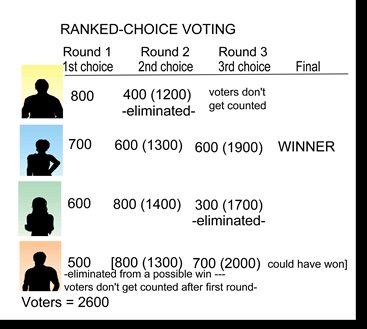RCV counting process can produce faulty results due to errors, inaccuracies, and complexity
The League of Women's Voters of Oregon has been running a TV ad in support of Measure 117, Ranked Choice Voting (RCV). The ad is misleading and may be mal-information. They state: "study after study, state after state confirms it’s effective” while displaying two articles that supposedly supports their statement. Those studies are articles written by NBC News,”New voting method that involves ranking candidates gains favor across the nation,” stating that 14 states will consider bills.
USA Today article, “Following a big year, more states push ranked-choice voting,“ simply cites who is using RCV, and not a study. USA Today cites California, Oregon counties and Florida cities.
The League’s ad seems to copy what FairVote Research says on their website. FairVote, a non-partisan organization, takes credit for getting Measure 117 on the ballot in Oregon. They do not identify one actual study done to come up with their ideology. They examined recounts and determined that there were not enough to be concerned about. The issue here is whether fraud can be proven or not, and they don’t seem to have an answer.
A study by the Report: Deficiencies in Recent Research on Ranked Choice Voting Ballot Error Rates (July 13, 2024) found that RCV causes an average of 17% more votes to directly affect the outcome between top candidates. This highlights the potential for inaccuracies in vote tallies.
Overall, studies that have been done highlight the ongoing debate and discussion surrounding ranked choice voting, with proponents arguing it can improve elections and opponents citing concerns about complexity and potential drawbacks of unintended results and transparency.
Some key findings and debates from these studies include:
- Inadequate testing and implemented incorrectly leading to errors.
- RCV’s complexity and difficult to understand leading to voter confusion.
- Lack of standardization leading to inconsistent application and potential errors.
- The impact of RCV on candidate quality and diversity.
- The effectiveness of RCV in reducing spoilers and vote splitting.
- The potential benefits of RCV in increasing voter satisfaction and participation.
- The need for further research and evaluation of RCV’s effects in different contexts.
A D V E R T I S E M E N T

A D V E R T I S E M E N T
In areas that have actually used RCV:
- Ballot Measure 2 in Alaska: The 2020 ballot initiative implemented RCV in Alaska, and opponents argue it is complicated and convoluted. It is on the ballot to repeal after the system provided a win to other than the most popular candidate.
- Ranked-Choice Voting in Missouri: Amendment 7, a ballot measure in Missouri, aims to ban RCV in the state. Proponents argue that RCV is unnecessary and would lead to confusing elections, while opponents claim it would increase voter participation and reduce spoilers.
- California’s 2023 Oakland Unified School District election, a court-ordered recount revealed errors that changed the outcome of the race.
- Maine’s 2018 primary election, errors were discovered in the RCV count, leading to a re-count and a changed winner.
Portland City Council races will be using RCV to select City Council members. Architects of the system hoped for a more diverse set of policymakers, and political experts predicted candidates would identify with policy-aligned slates and encourage voters to rank multiple candidates.
While ranked choice voting aims to promote more representative outcomes, its counting process can produce faulty results due to errors, inaccuracies, and complexity. To ensure the integrity of election results, it is essential to prioritize thorough testing, due diligence, and transparency in the counting process.
Failing this, the choice is to vote No on Measure 117.
--Donna Bleiler| Post Date: 2024-11-03 23:43:50 | Last Update: 2024-11-04 00:06:59 |







